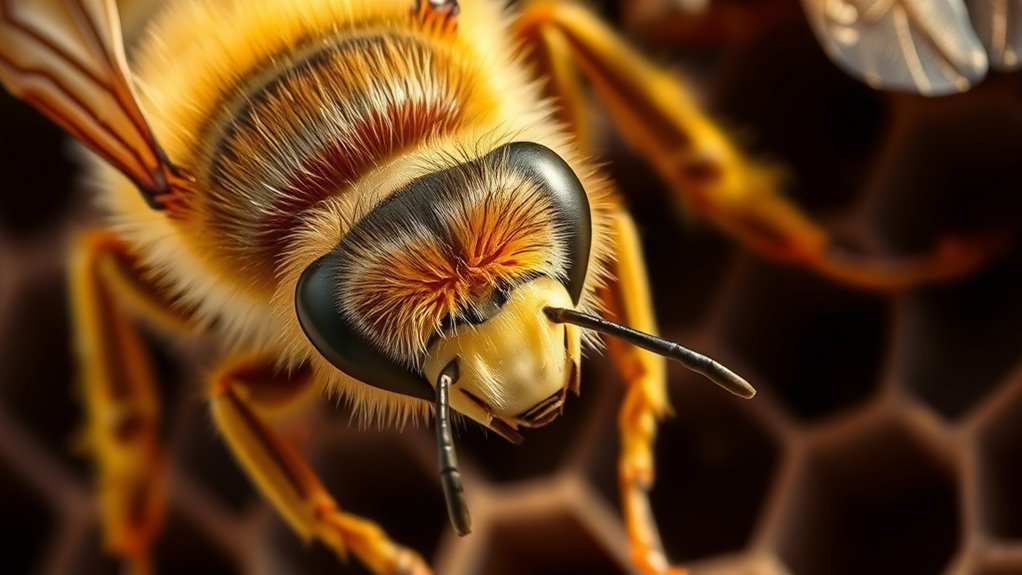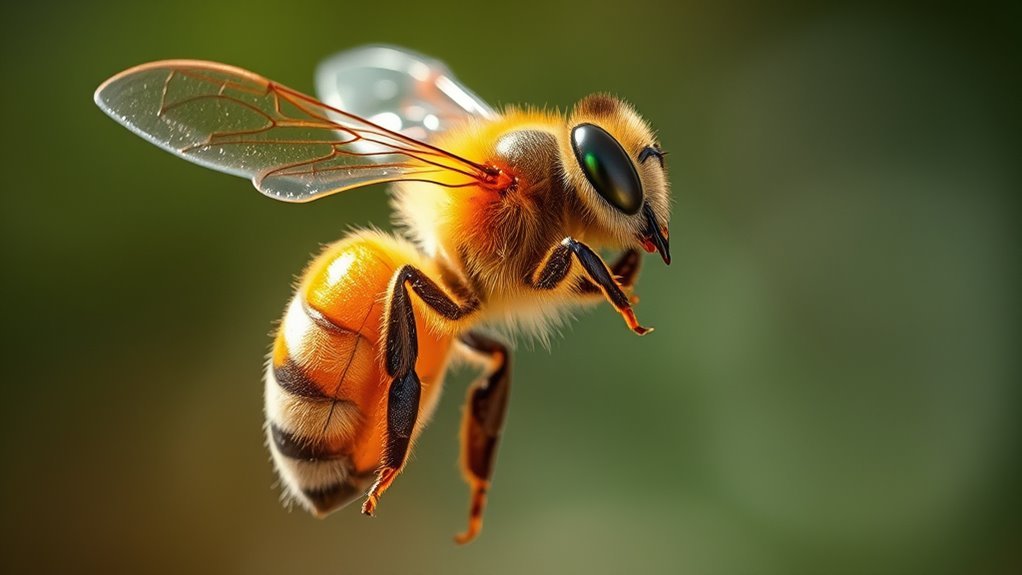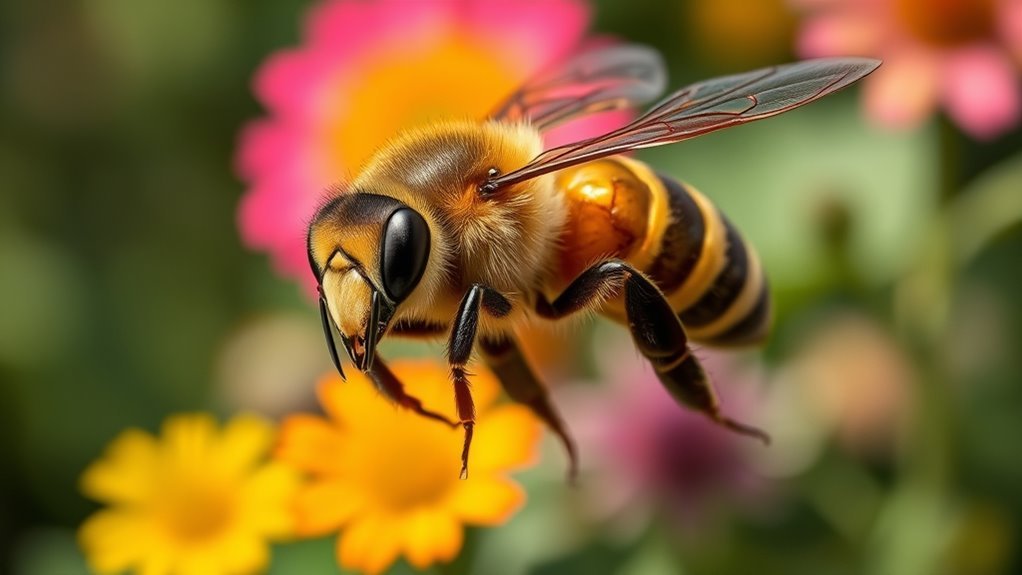Drone bees are larger than worker bees, measuring about 15 mm with robust bodies and no stingers, reflecting their reproductive role. Their wings are uniquely structured for efficient flight, with enhanced lift and navigation capabilities. Drones have specialized reproductive organs, producing significant sperm quantities needed for mating. They exhibit haploid genetics, influencing genetic diversity within the hive. Understanding these key features is essential in appreciating their role in the ecosystem and the dynamics of bee colonies.
Physical Characteristics of Drone Bees

Drone bees, the male members of a honey bee colony, exhibit distinctive physical characteristics that set them apart from their female counterparts. Their anatomy includes larger, robust bodies and particularly larger eyes, allowing for better navigation during mating flights. Drones lack stingers, a feature inherent to their role in reproduction rather than defense. Bee genetics play a significant role in determining these traits, influencing size, coloration, and overall vitality. Drones possess a haploid genetic structure, meaning they inherit one set of chromosomes from their mother, which affects their development and physical attributes. Understanding drone anatomy is essential for researchers and beekeepers alike, as it reveals the complex interplay of genetics and environmental factors that shape these important members of the hive.
Size and Shape Differences Compared to Worker Bees

The differences in size and shape between drone bees and worker bees are significant and reflect their distinct roles within the colony. In a size comparison, drones are typically larger, measuring around 15 mm, while worker bees average about 12 mm. Their stout, robust bodies are designed for mating rather than labor, leading to a unique shape analysis.
| Feature | Drone Bees | Worker Bees |
|---|---|---|
| Size | Larger (15 mm) | Smaller (12 mm) |
| Body Shape | Stout and robust | Slim and elongated |
| Purpose | Reproduction | Foraging and nursing |
Understanding these size and shape distinctions helps you appreciate the specialized roles each bee plays in maintaining the colony’s health and productivity.
Wing Structure and Flight Abilities

When examining drone bees, you’ll find that their wing structure is specifically adapted for their unique flight requirements. The anatomy of their wings, including size and muscle attachments, notably influences their maneuverability during mating flights. Understanding these factors will shed light on how drone bees navigate their environment effectively.
Wing Anatomy Overview
Wing anatomy plays a significant role in the flight capabilities of drone bees, enabling them to perform complex maneuvers essential for their role in the hive. The structure of their wings, characterized by a unique blend of wing flexibility and strength, allows for peak aerodynamic efficiency during flight. Each wing is composed of a thin, membranous structure supported by veins, which provides both rigidity and adaptability. This flexibility is essential, as it permits the wings to bend and twist, enhancing lift and reducing drag. In addition, the coordination between the fore and hind wings guarantees that drones can navigate efficiently through varying air currents. Understanding this anatomy helps to appreciate how drone bees maintain their freedom in flight, crucial for their reproductive and foraging activities.
Flight Maneuverability Factors
While drone bees possess remarkable flight capabilities, these abilities are intricately tied to their wing structure. Their wings allow for exceptional aerial agility, enabling complex flight patterns essential for mating and navigation.
| Wing Feature | Function | Impact on Flight Patterns |
|---|---|---|
| Wing Size | Larger than worker bees | Increases lift and stability |
| Wing Flexibility | High flexibility during flight | Enhances maneuverability |
| Stroke Frequency | Rapid wing beats | Facilitates quick directional changes |
These factors contribute to their effectiveness in the air, allowing drone bees to execute precise movements. Understanding these elements helps appreciate the evolutionary adaptations that support their survival and reproductive success in the hive.
Reproductive Organs and Their Function
Although drone bees primarily serve the purpose of mating with a queen, their reproductive organs are specifically adapted for this function, showcasing a fascinating evolution of structure and purpose. The reproductive anatomy of drone bees includes specialized genitalia that facilitate the mating process. Their testes produce sperm in large quantities, ensuring successful fertilization during copulation. When a drone mates, his endophallus, a unique organ, transfers sperm to the queen, often resulting in the drone’s death post-mating due to the detachment of his reproductive organs. This adaptation reflects a strategic evolutionary advantage, as it maximizes reproductive success despite the cost to the individual. These anatomical features exemplify the complex interplay between form, function, and the drive for genetic propagation within the hive.
Coloration and Markings
When examining drone bees, you’ll notice considerable variations in body color, which can range from deep black to lighter shades of brown. These color differences often correlate with specific genetic lineages and environmental factors. Additionally, distinctive marking patterns, such as bands or spots, play a vital role in identification and may influence mating behaviors within the hive.
Body Color Variations
Body color variations in drone bees play an essential role in their identification and ecological interactions. These variations can influence mating success and foraging behavior, as certain body color patterns may attract or repel potential mates.
| Body Color | Description |
|---|---|
| Dark Brown | Commonly found in many species, enhancing heat absorption. |
| Light Yellow | Often seen in specific regions, contributing to camouflage. |
| Orange Striped | Associated with aggressive behavior, signaling to predators. |
| Black and Yellow | A warning coloration, deterring potential threats. |
Understanding these color patterns not only aids in species identification but also provides insights into their ecological roles, unearthing the complex interactions that sustain their populations in diverse environments.
Distinctive Marking Patterns
Distinctive marking patterns in drone bees serve as critical identifiers within their species and play a significant role in their social dynamics. These unique patterns, often characterized by specific color combinations and arrangements, facilitate visual identification among bees, especially during mating flights. You’ll notice that drone bees typically exhibit broader, more vibrant markings compared to worker bees, which helps them stand out in a crowded hive. This visual differentiation isn’t just for aesthetics; it aids in recognizing kin and potential mates. Studies suggest that these marking patterns can influence reproductive success, as drones with more pronounced markings often attract attention from queens. Understanding these patterns provides insight into the evolutionary pressures shaping drone behavior and hive interactions.
Behavior and Social Role in the Hive
Although drone bees primarily serve the purpose of reproduction within the hive, their behavior and social role extend beyond mere mating. In the hive’s social hierarchy, drones hold a unique position, primarily influenced by their reproductive function. They do not participate in foraging or nursing; instead, they rely on worker bees for sustenance and care. Hive communication is essential, as drones respond to pheromones signaling readiness for mating flights. Their presence helps maintain hive cohesion, as they contribute to the overall population balance. Additionally, during swarming, drones may play a role in attracting new queens. Consequently, while drones are often seen as passive, their behaviors intricately weave into the hive’s complex social fabric, underscoring their significance beyond reproduction.
Life Cycle and Development of Drone Bees
As drone bees develop from fertilized eggs laid by the queen, their life cycle is distinctly tailored to the needs of the colony. The drone bee lifecycle begins when the queen deposits an egg in a specially constructed cell. After about three days, the egg hatches into a larva, which is then fed a nutrient-rich diet of royal jelly and pollen. This stage lasts roughly six days before pupation begins, lasting around a week. During this transformation, the drone bee develops its characteristic features, such as larger eyes and a robust body. Once fully developed, drone bees emerge from their cells ready for mating. Understanding drone bee development is vital, as it highlights their role in the reproductive success of the hive, ensuring genetic diversity.
Seasonal Presence and Population Dynamics
When examining the seasonal presence and population dynamics of drone bees, it is vital to recognize that their numbers fluctuate considerably throughout the year, influenced by environmental conditions and the needs of the hive. During spring and summer, you’ll witness significant population increases, driven by seasonal fluctuations in resources and the reproductive needs of the queen. In contrast, drone numbers diminish in fall, aligning with population trends that reflect the hive’s lifecycle.
| Season | Drone Population | Environmental Factors |
|---|---|---|
| Spring | High | Abundant flowers, warmth |
| Summer | Peak | ideal foraging conditions |
| Fall | Decrease | Resource scarcity |
| Winter | Minimal | Hive consolidation |
Understanding these dynamics is essential for fostering healthy colonies.
Importance of Drone Bees for Genetic Diversity
The seasonal fluctuations in drone populations directly impact the genetic diversity within a hive. Drones play an important role in the genetic contribution of the colony by participating in mating rituals that guarantee a varied gene pool. When you consider the limited mating windows, the presence of diverse drone populations becomes essential. Each drone’s unique genetic makeup influences the offspring’s resilience and adaptability, which is critical for coping with environmental changes. Additionally, a genetically diverse hive is less susceptible to diseases and predators. As a result, fostering healthy drone populations not only supports individual colonies but also strengthens the broader ecosystem. Fundamentally, the importance of drone bees transcends reproduction; it’s about securing the survival of future generations.
Frequently Asked Questions
How Do Drone Bees Contribute to Hive Maintenance?
Think of drone bees as nature’s guardians. They’re essential for drone reproduction, ensuring genetic diversity. While their hive roles may seem limited, they support overall health by aiding in mating and maintaining balance within the colony.
What Predators Are Known to Target Drone Bees?
Drone bees face various bee predators, including birds and wasps, which pose significant hive threats. Understanding these predators’ behaviors can help you better protect your hive and guarantee the survival of your drone population.
Can Drone Bees Survive the Winter Months?
Drone bees typically don’t survive winter months due to their winter behavior; they’re expelled from the hive. Their drone survival is minimal, as worker bees conserve resources for the queen and hive’s essential members.
Do Drone Bees Have Any Natural Enemies?
Drone bees face various predators, including wasps and birds, which can invade hives. Effective hive protection strategies, like worker bees’ vigilance and defensive behaviors, are essential to minimizing these threats and ensuring drone bee survival.
How Do Drone Bees Communicate With the Colony?
You might think drone bees are silent, but they play an essential role in hive dynamics. Through specific drone behavior, they communicate their presence and influence reproductive activities, ensuring the colony’s survival and genetic diversity.

